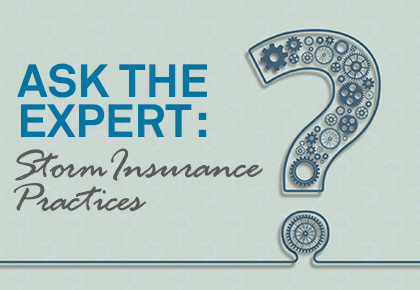Thursday March 04, 2021
Ask the expert: Storm insurance practices
In any given year, Texas associations must to know how to handle insurance claims, catastrophic or otherwise. For severe weather incidents and recovery efforts, knowing how the insurance claims process works is vital. It can be a handful, especially when dealing with the onslaught of resident storm damage insurance claim inquiries.Questions like:
- How does the cliams process work?
- What's the difference between contractor and adjuster estimates?
- Will this event affect our insurance rates next year?
Get answers to severe storm recovery and insurance issues in this video:
What does the overall claims process look like for residents and associations?
- Protecting the property
- Reporting claims
- Doing immediate repairs
- Collecting estimates
- Final restoration of property
Can you walk me through the claims adjustment process?
 It depends on if the circumstances are an act of God or an everyday insurance issue. Unlike regular claims, in catastrophic events you may encounter an independent adjuster since some carriers don't have their own, or all carrier-based adjusters are already out in the field. In that same vein, claims made as a result of devastating weather are prioritized. For example, if you live in a multifamily or high-rise community, the focus is to restore basic needs for all residents before tending to amenities and other shared spaces.
It depends on if the circumstances are an act of God or an everyday insurance issue. Unlike regular claims, in catastrophic events you may encounter an independent adjuster since some carriers don't have their own, or all carrier-based adjusters are already out in the field. In that same vein, claims made as a result of devastating weather are prioritized. For example, if you live in a multifamily or high-rise community, the focus is to restore basic needs for all residents before tending to amenities and other shared spaces.Within 48 hours of making a claim, an adjuster should be working with you to assess the damage. They will walk the property with you and your property manager, take measurements of rooms or spaces where damages have occurred (including common areas), and may take photos or use other specialized tools. The adjuster will use their software and collected data to return a report on damages and expected repair costs. This estimate is used by your insurance carrier to help determine the amount covered and paid by your insurance claim.
What should boards & residents expect from claims adjusters?
When an initial claim is submitted, it may not reflect all damages discovered in the waiting period before an adjuster is able to walk the property. It's up to the board and manager to ensure all damages under the association's responsibility are accounted for and the estimate adequately restores the community. For condominiums, this may mean managers will need to coordinate residential access by the adjuster if a water leak damaged multiple units or floors in your building.What are the best practices for getting estimates?
Again, this depends on if you're dealing with day-to-day claims or catastrophic, weather-related damages. For everyday claims, the recommendation is that everyone get 2-3 estimates. When it comes to weather-related damage, contractors and adjusters are extremely busy, so if you manage to snag one estimate, that's just as great. Be wary of "weather-chasers", contractors that show up only after severe weather. Make sure your management company has fully vetted your contractor and gone over the scope of work with your legal counsel. To mitigate your association's risk, check out our other recent Ask the Expert video "Severe Storm Recovery with RMWBH".Should boards compare estimates between adjusters and contractors?
Absolutely! Have your contractor review it with you to see the difference between the adjuster's estimate and the contractor's. It shouldn't come as a surprise if there is a significant difference, as contractors often see additional damages hidden inside walls where adjuster's aren't looking at the time of the walkthrough. However, it's important to contact your adjuster for additional details.Why should boards review their coverage annually?
Because associations go through many changes, including adding or removing amenities, and if your insurance isn't updated to match the changes you've made, you may not have the proper coverage when you need it.What are common items that aren't covered by insurance?
Nine times out of ten, landscaping is not covered, regardless of storm type or intensity. Damages caused by wind also usually fall under an additional insurance rider that most associations don't have.Will the recent events affect next year's insurance rates?
The market is already experiencing rate increases, and it's getting harder to meet underwriting guidelines. It's been ongoing for the past 18 months due to past storms, and I don't suspect that February's storms will make future circumstances any better. Hopefully, your management partner, like FirstService Residential, will have the leveraging power to work with preferred brokers to get your association the lowest rates and premiums on the coverage you need.FirstService Residential Ask the Expert webinar miniseries aims to answer the most frequently asked questions of associations throughout Texas on a variety of key topics. To get more information or submit a topic for our next Ask the Expert video, contact us at [email protected].